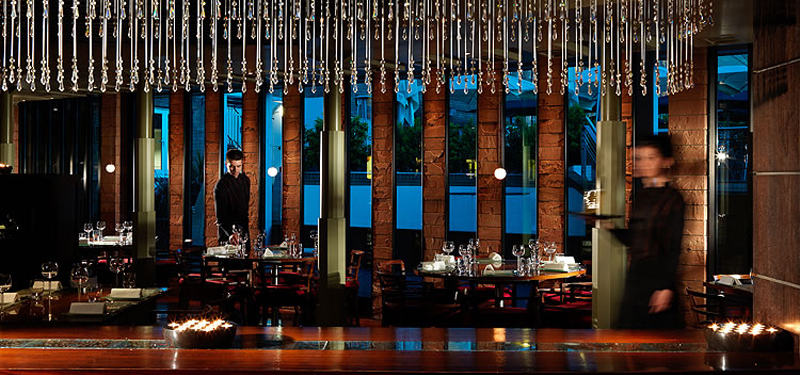
Situated in Belgravia, on Halkin Arcade off Motcombe Street, Amaya opened to critical acclaim in 2004, receiving and retaining a Michelin star since 2006, and taking its dining concept and inspiration from an age old approach to Indian Fine Dining: Stated on the inside cover of the menu, as the penchant for traditional Indian gourmets to graze through a selection of grilled delicacies before a grandstand finish of a special curry and a rich biryani.
On this midweek visit, Camellia Panjabi proved a most charming, knowledgeable and generous host to our group. Having had the pleasure of meeting Camellia on several occasions I was once again wowed as she shared her undimmed passion for the industry with a vim and vigour that belied any jet lag that she may have felt from her arrival earlier that week from Mumbai – working through a full daily itinerary, Camellia’s mixture of genuine warmth and dynamism proved infectious. Along with her sister Namita and brother-in-law Ranjit Mathrani, they have built a collection of highly successful Indian restaurants across London (See Profile).
In the past few months, over mid-week evening meals, I have sampled both Amaya and the equally impressive sister restaurant Chutney Mary. While the cooking and food offerings at each of these two restaurants represent a different focus – Chutney Mary provides a range of progressive Indian dishes mixed with some classics, whereas Amaya is broadly speaking ‘grill led’ – the two share a few things in common: An appreciation of what it takes to deliver a decor, ambience and atmosphere that strikes a chord with those that enjoy a lively evening buzz in a happy social (almost club like) dining environment. The mixture of dark wood, black granite and clever offset mood lighting amid splashes of colour encourages a first thought of young(ish) well-heeled professionals with some considerable disposable income. Then there is a second hit on this first impression which is a kind of ethereal sense of well being that might draw in the diner of any demographic and from a scan of each room, both the former and latter hold true.
I would imagine a glance at the reservations databases of these restaurants would demonstrate that the customer profile has some significant cross fertilisation, particularly in the evenings. A further element these two eateries share in common is the importance of high quality service, particularly for first time diners. Why? The menus are broad and it is important as a customer to be educated by the service on how to navigate the menu to best enjoy the food on offer.
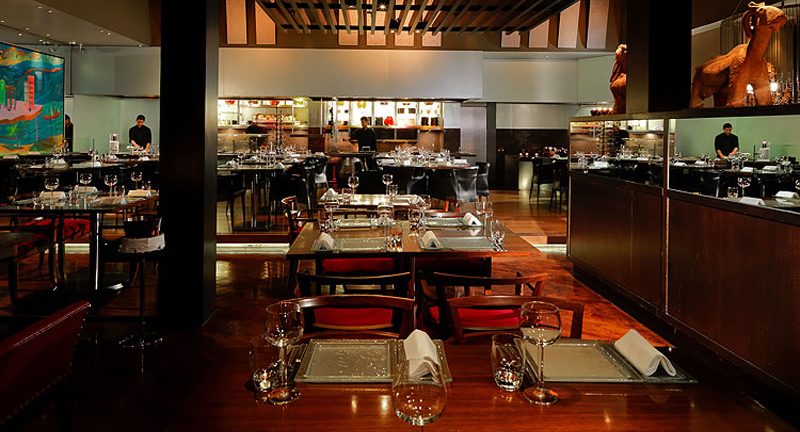
As an example, Amaya has an impressive open kitchen (above) with a salad section, tandoor (clay oven), sigri (charcoal grill) and tawa (griddle) which facilitate a rather broad menu of three different tasting choices, a few curries, bread and rice. However, the main focus is found across a selection of over 30 Salad, Seafood, Poultry and Meat dishes that are divided up by ‘first to arrive’, ‘mid-arrivals’, ‘later arrivals’ and curries. At first glance it is possible to feel a little overwhelmed, however, the levels of service provided by the waiting staff shine through and would appear shared across the group, reflecting the owners passion to inform, encourage and enjoy the most balanced selections of Indian fine dining.
Camellia explained on the tour of the open kitchen that Amaya take 90% of supplies daily reflecting the deliberately limited storage space in the kitchen. Salads are prepared at time of order, all grills are cooked and served immediately and there is no compromise on quality – Grass fed Welsh lamb, Normandy duck and Madagascan giant prawns. On top on this, the quality of spicing is seen as critical to success in the flavours of the prepared house specialities. The spices are acquired during their peak time within the spice harvest in India to ensure the best of the crop! So for example, the Kashmiri chilli grown near Hubli is harvested from 14 January onwards – the best of the crop sells out within a week! Reshampati chillies are harvested in the middle of March whereas cumin and coriander in early April.
So as well as optimising provenance of ingredients and spices, the cooking techniques to produce taste, texture and temperature are fundamental. Dishes have their own marinades, cooking oils and chutneys are made fresh and in-house. Outside of the centrepiece grazing dishes are the three curries and two biryanis that change each month. The kitchen operates brigade of around 15 chefs with a flattish organisation structure. In addition, there is at least twenty front of house staff.
A sample of dishes follow. The minced chicken lettuce parcels delivered on crisp freshness with a burst of Asian herbs and spices.
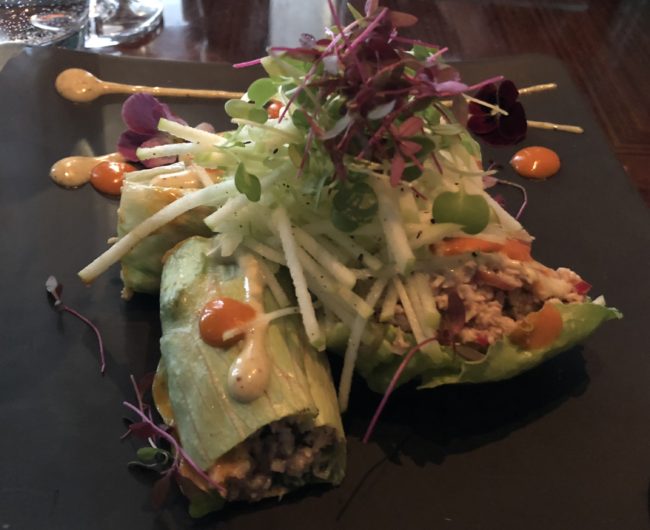
Black Pepper Chicken Tikka maintained a delicate texture which was lifted by a rich pepper marinade that defied any dryness that would have become evident in the slightest of overcooking. This proved a happy feature which purveyed throughout the meal. Indeed Venison Seekh Kebabs retained a moisture and tenderness that again defied any mistimings that might be evident in lesser kitchens.
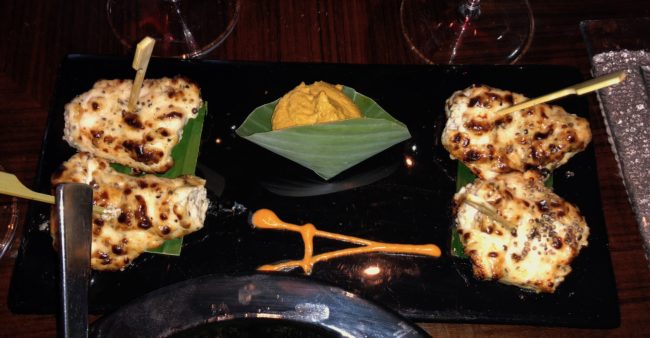
A fine seafood platter made up of Tandoori Ocean Wild Prawns (Madagascan) perfectly timed to retain moisture and texture of the delicate shellfish and complemented by lightly spiced tomato and ginger marinade. King Scallops, diver caught, seared with appropriately delicate seasoning which worked with the natural sweetness of the flesh and enhanced rather than overwhelmed by a gentle herby sauce. Finally, Rock Oysters, flash grilled with a coconut and ginger sauce offered an unusual but appealing taste that lingered on the palate for a good 10 seconds.
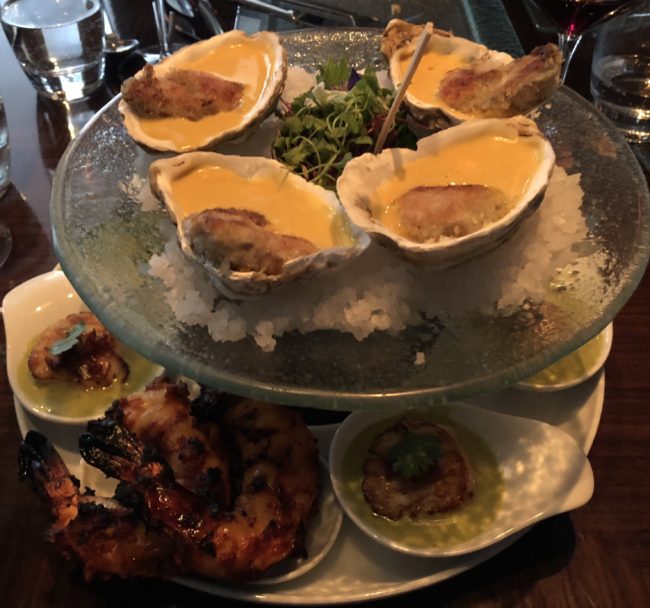
Amaya is proud of their selections of vegetable dishes that for ‘first to arrive’ include Tandoori Organic Paneer Tikka, Goats Cheese and Yogurt Kebabs, small peppers with ginger, soft cheese and cashew nut. Shakarkhand Chaat which is a griddled Indian white sweet potato. ‘Mid Arrivals’ for vegetables include Tandoori Broccoli (below) with a ginger infused yoghurt, griddled portobello mushrooms or Spinach Fig Tikki.
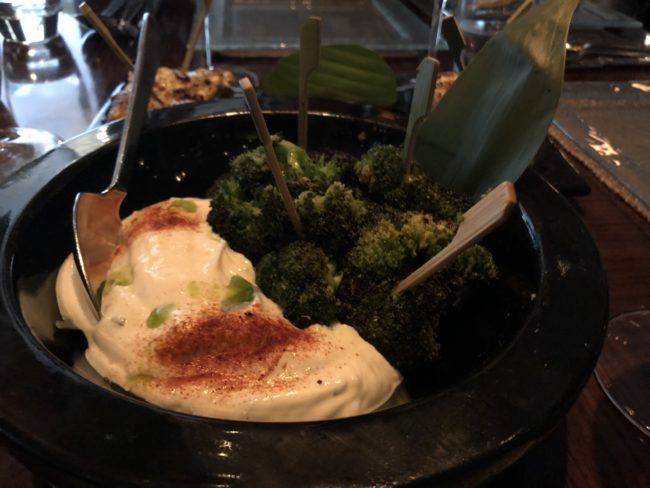
The selection of curries enjoyed such as a Nimbu Gosht – best described as a lamb Osso-Bucco, which by definition is slow cooked in light spices to fall off the bone from tenderness, the dish served with fresh lime to cut the richness and caramelised onions that added sweetness. Other delights included a prawn Biryani, a Badami Chicken Curry or a Kerala Prawn Curry. Bread and rice finish the feast of savoury dishes.
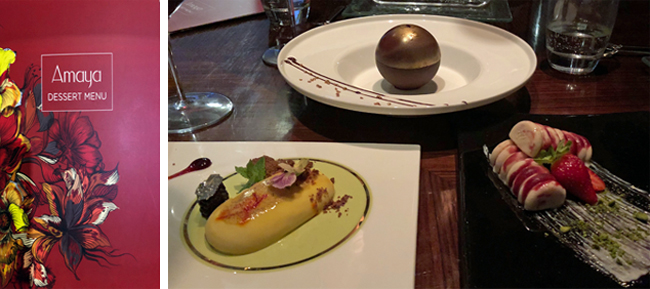
A trio of signature desserts, each of which may be served with a specially selected sweet wine. A chocolate Rasmalai, Saffron and Cardamom Pannacotta and Strawberry Malai Kulfi proved a satisfying and sweet conclusion to the meal.
London consumers have become increasingly discerning in all they consider, due partly perhaps to the breadth of information available via web content and social media, something which naturally encourages people to become more adventurous in their tastes. Indeed all aspects of established, emerging and new cuisines are affected by what appears to be a continuous search for expression, authenticity and individuality.
In fact, the speed of this observed change is witnessed simply in the tea and coffee menus at Amaya which read like the kind of sophisticated notes once reserved for 1855 classification Grand Cru Classe wines. Consider Balseri Gold 2nd Flush Assam – 2016 rich, sweet, malty and full bodied tea typical of Assam or a Wonder Classic Darjeeling, 1st Flush Gopaldhara Gardens – 2017 tropical fruit notes, papaya, mango with sweet white florals.
Where once coffee was black or white before Espresso, Cappuccino and Latte were imported into restaurant fayre so now it is Indian Monsoon Blend which is fragrant and smokey with dark caramel overtones which is blended with the exclusive Indian cherry parchment coffee. This is not intended to be critical but instead to highlight the need for restaurants to deliver this detail on quality, that is now ‘par for the course’ where informed customers are concerned!
As well as feeding the local clientele, clearly Amaya is a destination restaurant, patronage of the restaurant is strong all round because the offering is strong all round – forever evolving to meet the changing demands of the market, ably watched over by Camellia Panjabi, whose wisdom reflects her years but whose dynamism, focus and passion retain a perennially youthful outlook and insight. Long may they continue!



